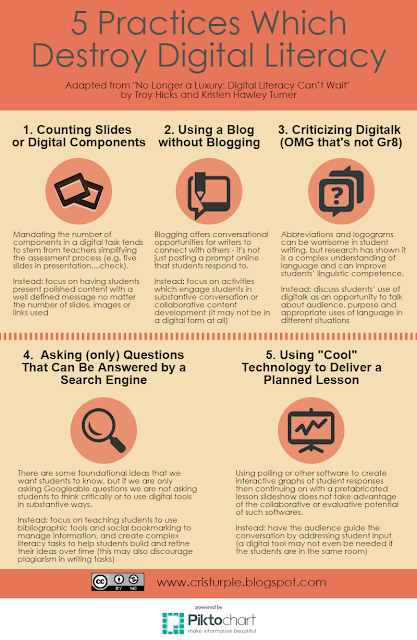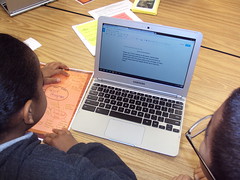For a number of years now, I have been wanting to provide elementary colleagues with a book that offers a glimpse inside a classroom that runs as a digital writing workshop, one that truly embraces the principles of writing workshop pedagogy while integrating digital writing tools into day-to-day literacy practices. I have been fortunate to connect with many elementary educators who embrace the writing workshop approach with digital writing tools, but hadn’t yet seen a book that captured, in words and images, what a digital writing workshop might look like.

Then, last year, I found out that Katie Muhtaris and Kristin Ziemke were working on a book to be based on some of the techniques and strategies they share in their blog, “Innovate Ignite Inspire.” Knowing that they were doing this kind of smart work with their kids, I have been eagerly awaiting their book. The result is Amplify: Digital Teaching and Learning in the K-6 Classroom.
Now, having met Kristin quite some time ago at a Michigan Reading Association conference, I knew that she was an educator who was a bit skeptical about the use of technology, but wanted to integrate tech in productive, responsible ways. Or, as Stephanie Harvey describes it in the foreword of the book, though Katie had been enthusiastically integrating technology in her classroom for number of years and, subsequently, Kristin would “peek in, curious about how tech platforms might enhance learning in her first-grade classroom, but not entirely convinced” (vii).
Just as its title suggests, Katie and Kristin’s book does not supersede or replace existing literacy practices with technology-enhanced lessons. Instead, their goal is, indeed, to amplify best practices in reading and writing workshop, modeling literacy practices for their students, and moving them toward a hybridity of reading and writing in both print and digital spaces. As they explain:
Digital learning is at a crossroads, and it’s time for teachers and students to share our voices in how, why, and when our kids should use technology as a learning tool. We invite you to join us on a journey of discovery, exploration, and empowerment. (xii)
Their core principles are ones with which I, and countless other teachers, would certainly agree:
- Use a workshop model for instruction
- Hold small-group and individual conferences
- Engage kids in cross-curricular content
- Scaffold learning
- Encourage collaboration and conversation
- Drive instruction with assessment
These principles align with their overarching goal — “Technology in the classroom fits easily into this hands-on approach to learning (the writing workshop): our students should be the ones using it” (5).
They back these principles up with numerous examples, and I especially appreciate the way that they create “technology anchor charts” in much the same way they would when exploring a new genre, discussing reading strategies, or documenting a process. Also, they describe how they adapt the workshop model by adding in the element of “play” before a mini lesson. “Play,” they contend, “is collaborative, experiential, tactile, and active,” all ideas that lend themselves well to using technology (33).
The book itself takes the voice that we have come to expect in all Heinemann titles — respectful of teachers’ time, knowledge, and needs for high-quality professional learning and growth. Rather than providing a buffet of tech tools, Katie and Kristin actually focus their efforts on just a few key tools and processes: capturing ideas with Padlet, engaging students in a backchannel with Today’s Meet, teaching them how to record voice and video with a webcam and microphone. Throughout the book, there are suggestions that a teacher can “try tomorrow” with minimal technology knowledge.
As the book comes to a close, they share insights on reflection and assessment. Regardless of any number of digital tools at their disposal, Katie and Kristin remind us that
The simple act of giving ourselves permission to stop and watch opens our eyes to the rich fabric of learning in our classroom. We can examine the quality of the tasks we ask our students to undertake. What impact do they have? Why is this important? How can this be better? (90)
Amplify has provided elementary teachers a glimpse into the workings of what I would call a digital writing workshop and what Franki Sibberson has recently begun to call a “digital reading workshop” in Digital Reading: What’s Essential in Grades 3-8. Though I am curious as to why Katie and Kristin do not use that language, I imagine that they avoid adding the “digital” label to the work that they do for good reason — to keep the focus on reading and writing, thinking and learning. As we all continue to think about ways in which we can purposefully bring technology into the K-6 classroom, Amplify provides us with both the principles and practices for doing so.
NOTE: While I am a Heinemann author and did request a complimentary copy of this book, please know I am writing this review independently, not at the request of Heinemann or the authors.
Update: 12/10/15, 11:33 PM – Katie was kind enough to point out that I transposed two letters in “Padlet,” so that has been corrected.

This work is licensed under a Creative Commons Attribution-NonCommercial-ShareAlike 4.0 International License.







